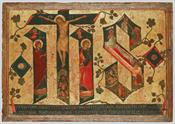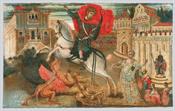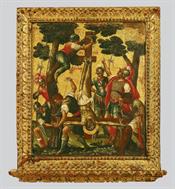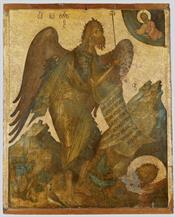Society and art in Venetian Crete
Description
Exhibition Space Text DescriptionAround 1453, after the fierce clashes of the 13th and 14th c., a modus vivendi had been reached between the Venetian conquerors and the native Cretan aristocracy. While the situation of the lower classes was tending to get worse as time went by, the mixed (Veneto-Cretan) upper social strata which emerged maintained direct links with Venice and created cultural products of high artistic value from the mid 15th c. onwards. In the 16th and 17th c., after three centuries of the Venetian presence on the island, structures had been created, which on the one hand were reminiscent of Western European feudalism and/or the former Byzantine regime, and on the other resembled those of contemporary Italian city states. The art of Venetian Crete appropriated both Byzantine and Late Gothic forms, often combined with Renaissance or Baroque elements. It was a clear reflection of a society with a variety of reference points, balanced between the Middle Ages and Modern era.
Exhibits
-
 Jesus Hominum Salvator
Icons and Wood-Carvings Depictions of the Crucifixion, the Resurrection and the Descent into Hell are combined in the initials of the abbreviated Lat...
Jesus Hominum Salvator
Icons and Wood-Carvings Depictions of the Crucifixion, the Resurrection and the Descent into Hell are combined in the initials of the abbreviated Lat... -
 Saint George the Dragon-Slayer
Icons and Wood-Carvings In the scene Saint George in military dress and on horseback while slaying a winged dragon with his spear. This is the most f...
Saint George the Dragon-Slayer
Icons and Wood-Carvings In the scene Saint George in military dress and on horseback while slaying a winged dragon with his spear. This is the most f... -
 The Crucifixion of St Andrew
Icons and Wood-Carvings The icon presents the scene of the Martyrdom of St Andrew who was crucified upside down. It was painted by Michael Damaskenos...
The Crucifixion of St Andrew
Icons and Wood-Carvings The icon presents the scene of the Martyrdom of St Andrew who was crucified upside down. It was painted by Michael Damaskenos... -
 St John the Baptist
Icons and Wood-Carvings The saint is depicted in a stony desert, winged and conversing with Christ, who is shown blessing. At the bottom right the sa...
St John the Baptist
Icons and Wood-Carvings The saint is depicted in a stony desert, winged and conversing with Christ, who is shown blessing. At the bottom right the sa...
Comments
Users must be registered and logged in to comment.
No comments found.